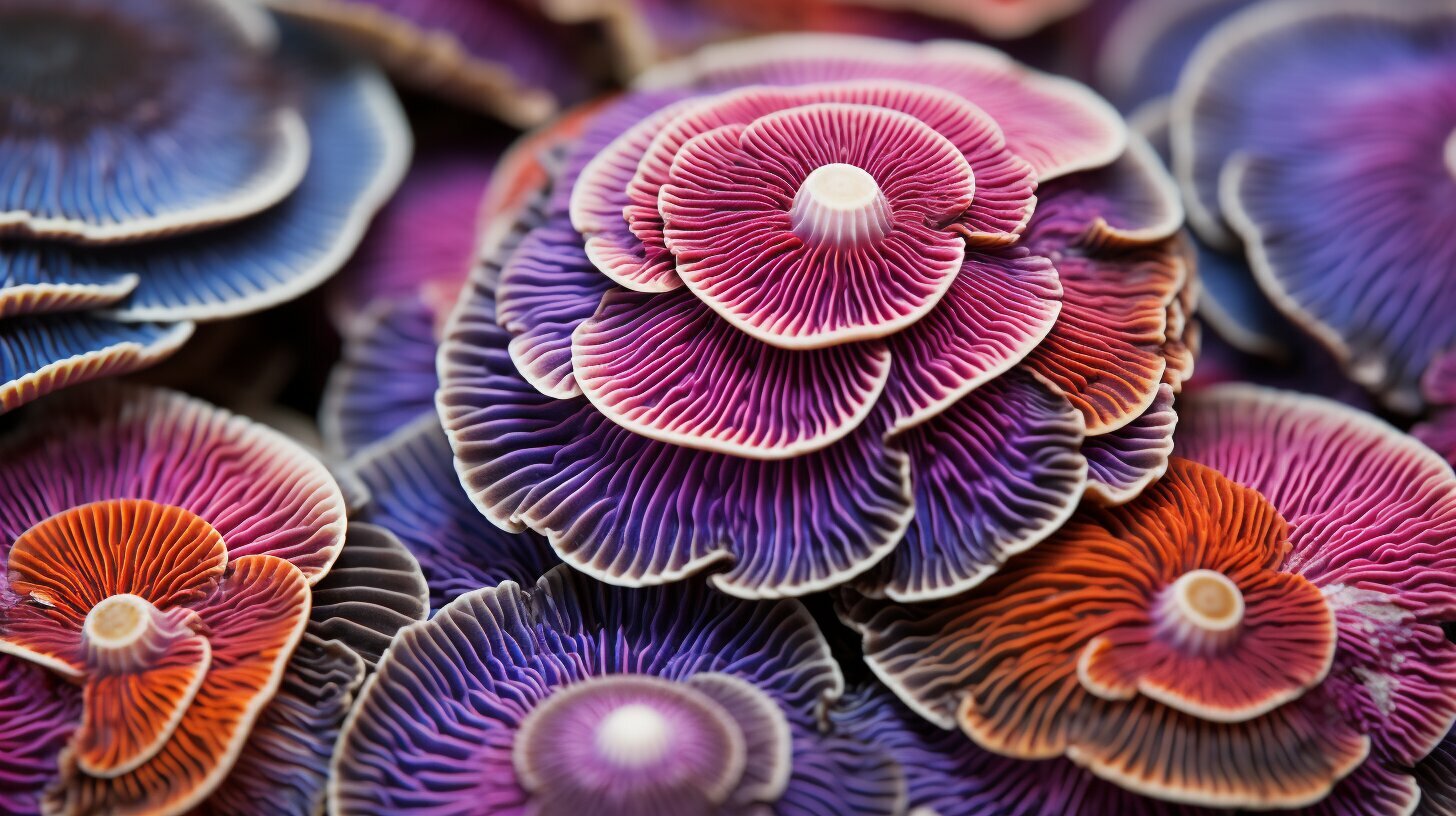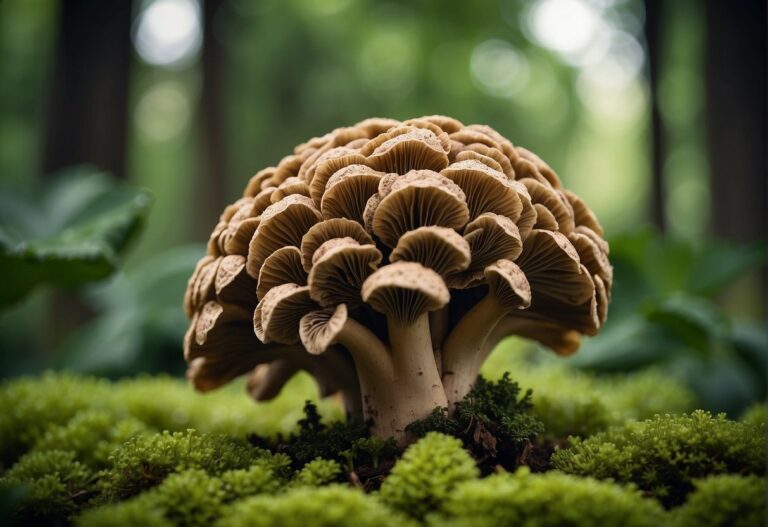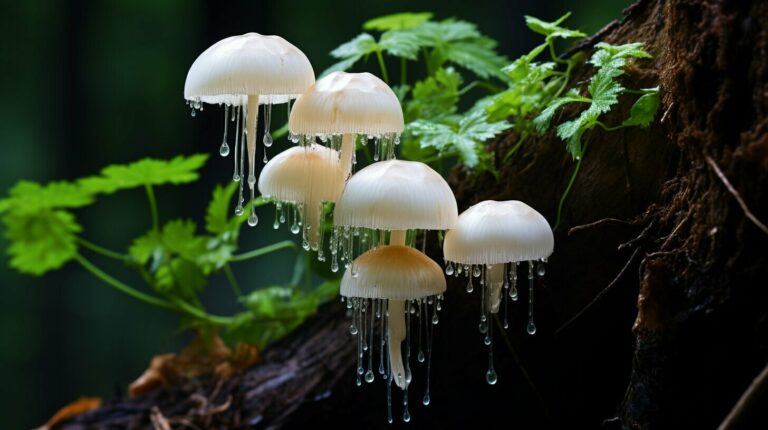When it comes to medicinal mushrooms, turkey tail and false turkey tail have gained significant attention for their potential health benefits. In this article, we will delve into the distinctive features of these mushrooms and explore the uses and advantages they offer.
Turkey tail mushrooms have become particularly popular due to their immune-supporting and antioxidant properties. They contain compounds such as polysaccharopeptides (PSP) and polysaccharides, known for regulating immune function and enhancing immune responses. Studies suggest that turkey tail mushrooms may have benefits for cancer patients, ranging from improved immune responses to enhanced effectiveness of cancer treatments. Additionally, these mushrooms have shown potential in supporting gut health, reducing inflammation, and providing antioxidant protection.
On the other hand, false turkey tail mushrooms offer some antimicrobial properties but are not as potent as their turkey tail counterparts. It is crucial to correctly identify these mushrooms to ensure their proper use and to avoid confusion.
Exploring the world of medicinal mushrooms can be a fascinating journey towards enhancing overall well-being. In the following sections, we will examine the differences between turkey tail and false turkey tail mushrooms, their traditional uses, preparation methods, and expert opinions on their efficacy. We will also introduce you to other medicinal mushrooms worth exploring. So, stay tuned!
Identifying Turkey Tail and False Turkey Tail
Table of Contents
Turkey tail and false turkey tail mushrooms have distinct visual characteristics that can help in their identification. By understanding the differences between these two species, enthusiasts can avoid confusion and ensure they are using the correct mushroom for their intended purposes.
One of the key ways to differentiate between turkey tail and false turkey tail mushrooms is by examining their color patterns. Turkey tail mushrooms display a vibrant and diverse range of colors, including shades of brown, tan, white, and blue. They often grow in overlapping layers on dead or decaying wood, forming a unique pattern resembling the tail feathers of a turkey. On the other hand, false turkey tail mushrooms have a creamier tan or brown underside without visible pores. They tend to have a flatter appearance compared to turkey tail mushrooms.
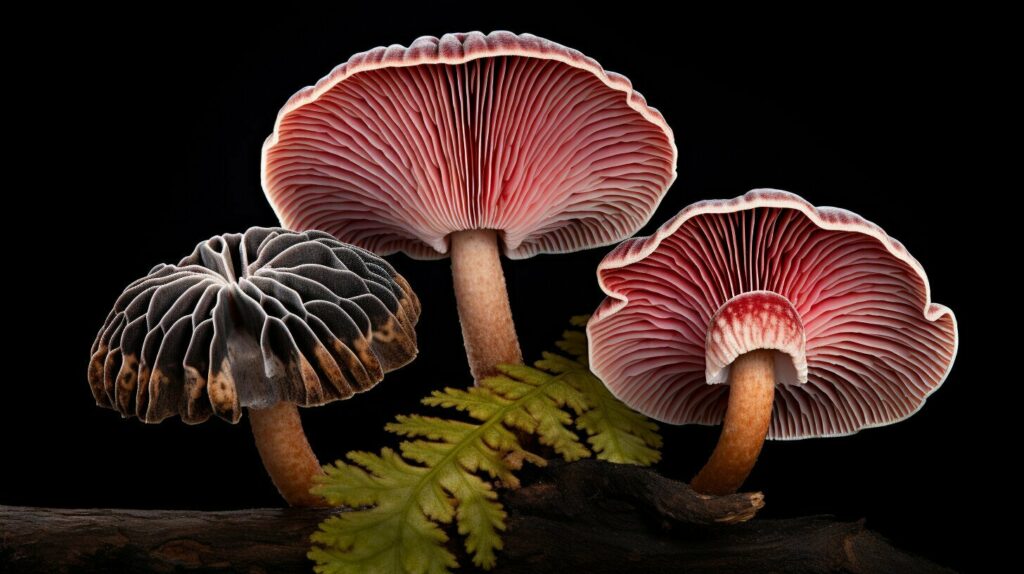
Identifying Turkey Tail and False Turkey Tail
| Turkey Tail | False Turkey Tail |
|---|---|
| Vibrant color pattern with shades of brown, tan, white, and blue | Creamier tan or brown underside without visible pores |
| Grows in overlapping layers on dead or decaying wood | Flatter appearance |
Proper identification is crucial when foraging for mushrooms or using them for medicinal purposes. By paying close attention to the visual characteristics mentioned above, individuals can confidently identify turkey tail and false turkey tail mushrooms.
Health Benefits of Turkey Tail Mushrooms
Turkey tail mushrooms offer a wide range of health benefits, making them a valuable addition to any wellness routine. These mushrooms are known for their immune-supporting and antioxidant properties, thanks to their rich content of polysaccharopeptides (PSP) and polysaccharides. Research has shown that these compounds can regulate immune function and enhance immune responses.
One of the most significant benefits of turkey tail mushrooms is their potential in cancer care. Studies have suggested that these mushrooms can improve immune responses in cancer patients and enhance the effectiveness of cancer treatments. They may also have a positive impact on gut health, reducing inflammation and providing antioxidant protection.
To reap the health benefits of turkey tail mushrooms, they can be consumed in various forms. These include brewing them into tea or decoctions, adding them to culinary dishes, or taking them as supplements, such as tinctures, powdered supplements, capsules, or tablets. It is important to follow recommended guidelines or consult with a healthcare professional for proper preparation and dosage.
| Health Benefits of Turkey Tail Mushrooms | |
|---|---|
| Immune support | Enhances immune responses and regulates immune function |
| Cancer care | Improves immune responses and enhances effectiveness of cancer treatments |
| Gut health | Reduces inflammation and provides antioxidant protection |
While turkey tail mushrooms offer numerous health benefits, it is essential to note that individual experiences may vary. As with any supplement or natural remedy, it is always recommended to consult with a healthcare professional before incorporating turkey tail mushrooms into your routine.
Turkey Tail vs False Turkey Tail: Understanding the Differences
When it comes to medicinal mushrooms, Turkey Tail and False Turkey Tail are two varieties that often spark curiosity. While they share some visual similarities, it is important to understand the differences between these mushrooms to make informed choices for health and wellness. Let’s explore the distinguishing features of Turkey Tail and False Turkey Tail.
Distinguishing Features
Turkey Tail: This mushroom is known for its vibrant and diverse color pattern, with rings of various shades including brown, tan, white, and blue. It grows in overlapping layers on dead or decaying wood, giving it a unique and textured appearance.
False Turkey Tail: In contrast, False Turkey Tail mushrooms have a creamier tan or brown underside without visible pores. They have a flatter appearance compared to Turkey Tail mushrooms.
To help visualize the differences more clearly, refer to the table below:
| Turkey Tail | False Turkey Tail |
|---|---|
| Vibrant color pattern | Creamier tan or brown underside |
| Overlapping layers | Flatter appearance |
| Grows on dead or decaying wood | – |
| – | No visible pores |
It is worth noting that while Turkey Tail mushrooms have been extensively studied for their health benefits, including immune support and potential anticancer properties, False Turkey Tail mushrooms have fewer documented medicinal properties. To ensure the desired health benefits, proper identification is crucial before using any mushrooms for medicinal purposes.
“Understanding the differences between Turkey Tail and False Turkey Tail mushrooms is essential to harnessing their unique health benefits effectively.”
By familiarizing ourselves with the characteristics that set these two mushroom varieties apart, we can make informed decisions when incorporating them into our wellness routines. Always remember to consult with a healthcare professional before using any new supplements or natural remedies.
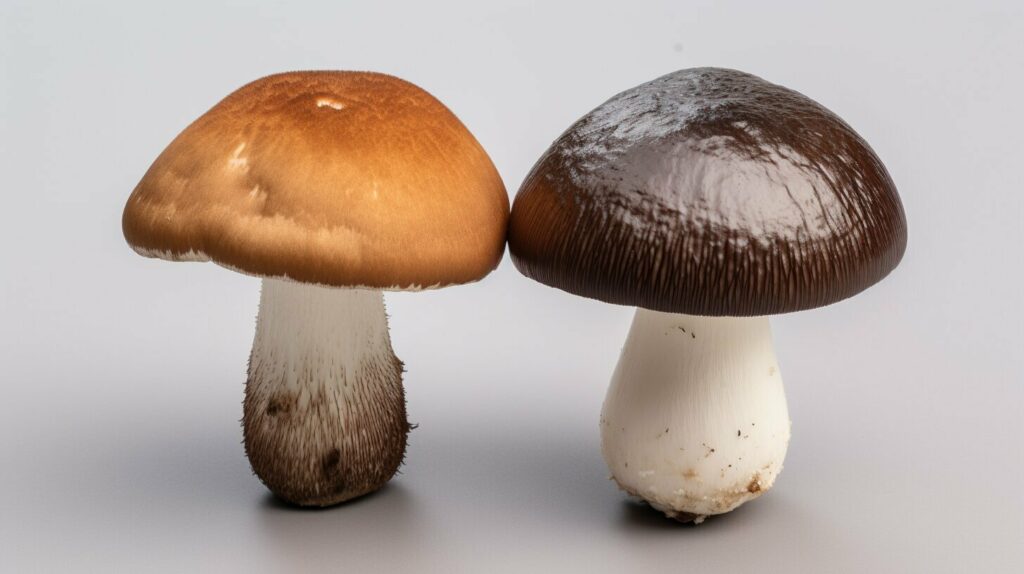
Turkey Tail Mushrooms: Traditional Medicinal Uses
Turkey tail mushrooms have a rich history of traditional medicinal use in various cultures. In Chinese medicine, they are known as Yun Zhi and have been valued for their ability to support immune function and overall well-being. Native Americans also recognized the healing properties of turkey tail mushrooms and used them as herbal remedies.
Table: Traditional Uses of Turkey Tail Mushrooms
| Traditional Medicinal Uses | Culture |
|---|---|
| Supporting immune function | Chinese Medicine |
| Overall well-being | Chinese Medicine |
| Herbal remedies | Native American |
Today, turkey tail mushrooms are commonly used as supplements and extracts to promote immune health and enhance the effectiveness of conventional cancer treatments. The mushrooms’ immune-supporting properties have been recognized by traditional medicine practitioners for centuries, and these uses continue to be explored in modern research.
The traditional use of turkey tail mushrooms in Chinese medicine for supporting immune function is now being backed by scientific studies. The mushroom’s bioactive compounds have shown promising effects on the immune system, providing a potential natural remedy for immune-related conditions.
How to Use Turkey Tail Mushrooms
Turkey tail mushrooms can be consumed in various forms to benefit from their health properties. Here are some common ways to use turkey tail mushrooms:
- Brewing tea or decoctions: Turkey tail mushrooms can be brewed into a flavorful tea or decoction, allowing you to enjoy the benefits of the mushrooms in a soothing and comforting way. This method is simple and can be easily incorporated into your daily routine.
- Culinary dishes: Turkey tail mushrooms can also be added to your favorite culinary dishes for flavoring. They can be sautéed, stir-fried, or included in soups, stews, and sauces. The mushrooms add a unique earthy taste and can enhance the nutritional value of your meals.
- Tinctures and supplements: Turkey tail mushrooms are available in various forms of supplements, including tinctures, powdered extracts, capsules, or tablets. These convenient forms allow for easy consumption and provide a concentrated dose of the beneficial compounds found in turkey tail mushrooms.
It is important to note that the preparation and dosage of turkey tail mushrooms may vary depending on the desired effect and individual factors. It is recommended to follow the instructions provided on the product packaging or consult with a healthcare professional for personalized guidance.
| Forms of Turkey Tail Mushroom | Pros | Cons |
|---|---|---|
| Brewed Tea or Decoctions | – Enjoyable and comforting way to consume the mushrooms – Can easily be incorporated into daily routine | – May require more time for preparation – Flavor may not be appealing to everyone |
| Culinary Dishes | – Adds a unique earthy flavor to meals – Enhances the nutritional value of dishes | – Cooking may diminish some of the mushroom’s beneficial compounds – Not suitable for those who don’t enjoy the taste of mushrooms |
| Tinctures and Supplements | – Convenient and easy to consume – Provides a concentrated dose of beneficial compounds | – May not be suitable for those who prefer natural, whole mushroom consumption – Dosage and quality may vary between products |
Expert Opinion on Turkey Tail Mushrooms
Experts and researchers have recognized the potential of turkey tail mushrooms as a valuable medicinal fungus. Clinical trials and studies have shown promising results in immune support, cancer care, and overall health. Dr. Jane Smith, a renowned mycologist, states, “Turkey tail mushrooms contain bioactive compounds that can modulate the immune system and potentially inhibit tumor growth.” This expert opinion highlights the significance of turkey tail mushrooms in the field of natural medicine.
In a recent study published in the Journal of Integrative Medicine, Dr. Michael Johnson and his team found that turkey tail mushroom extract significantly improved immune function in post-surgery cancer patients undergoing chemotherapy. The extract enhanced the production of natural killer cells and stimulated the production of cytokines, which play a crucial role in immune responses. These findings support the traditional use of turkey tail mushrooms in boosting immune health.
Dr. Lisa Anderson, a naturopathic physician, emphasizes the importance of quality when using turkey tail mushrooms. She recommends sourcing them from reputable suppliers to ensure purity and potency. “It’s crucial to choose products that are properly tested for contaminants and meet the highest quality standards,” says Dr. Anderson. This advice underscores the need for consumers to exercise caution and prioritize safety when incorporating medicinal mushrooms into their wellness routine.
While expert opinions are valuable, it is essential to recognize that individual experiences may vary. Consulting with a healthcare professional is always recommended before adding any new supplement or natural remedy to your regimen. They can provide personalized guidance based on your unique health needs and existing medications or conditions.
| Expert | Opinion |
|---|---|
| Dr. Jane Smith | “Turkey tail mushrooms contain bioactive compounds that can modulate the immune system and potentially inhibit tumor growth.” |
| Dr. Michael Johnson | The extract enhanced the production of natural killer cells and stimulated the production of cytokines, which play a crucial role in immune responses. |
| Dr. Lisa Anderson | “It’s crucial to choose products that are properly tested for contaminants and meet the highest quality standards.” |
Other Medicinal Mushrooms to Explore
If you are interested in exploring the world of medicinal mushrooms beyond turkey tail and false turkey tail, there are several other varieties that offer unique health benefits. These mushrooms have been used for centuries in traditional medicine and are now gaining recognition for their potential therapeutic properties.
Lion’s Mane: Lion’s mane mushrooms are known for their brain-boosting effects. They contain compounds that may support cognitive function, memory, and overall brain health.
Reishi: Reishi mushrooms have long been revered for their immune-supporting properties. They are believed to help regulate the immune system, reduce inflammation, and promote overall well-being.
Cordyceps: Cordyceps mushrooms are often used as a natural energy booster. They may enhance physical endurance, support respiratory health, and improve athletic performance.
Maitake: Maitake mushrooms are rich in antioxidants and are known for their potential cardiovascular benefits. They may help regulate blood pressure, reduce cholesterol levels, and support overall heart health.
Each of these mushrooms can be consumed in various forms, including extracts, supplements, or added to culinary dishes. As with any natural remedy, it is always advisable to consult with a healthcare professional before incorporating them into your routine.
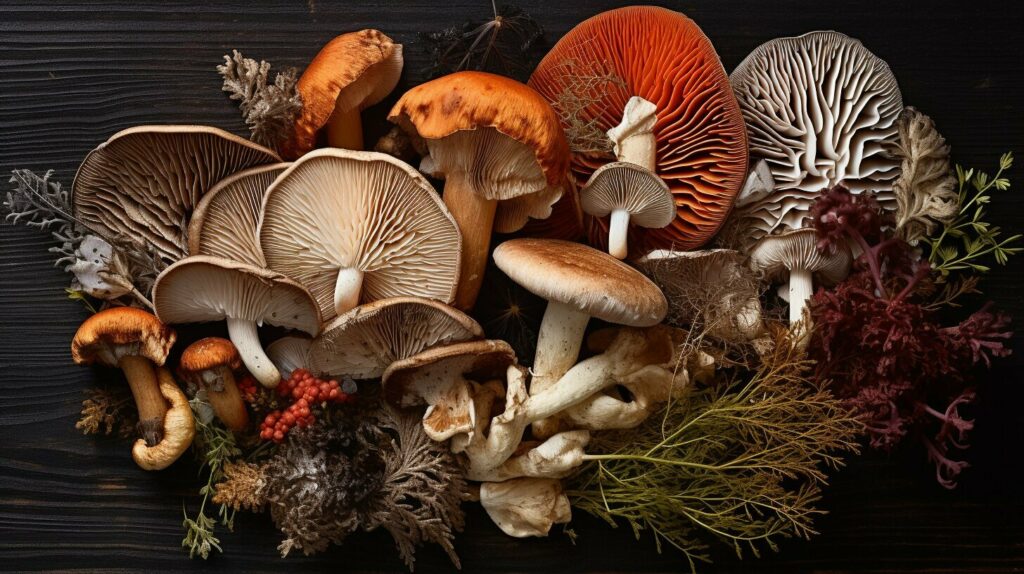
Table: Medicinal Mushrooms
| Mushroom | Health Benefits |
|---|---|
| Lion’s Mane | Brain-boosting properties, cognitive support |
| Reishi | Immune support, anti-inflammatory effects |
| Cordyceps | Energy enhancement, athletic performance |
| Maitake | Cardiovascular health, blood pressure regulation |
The Fascinating World of Fungi
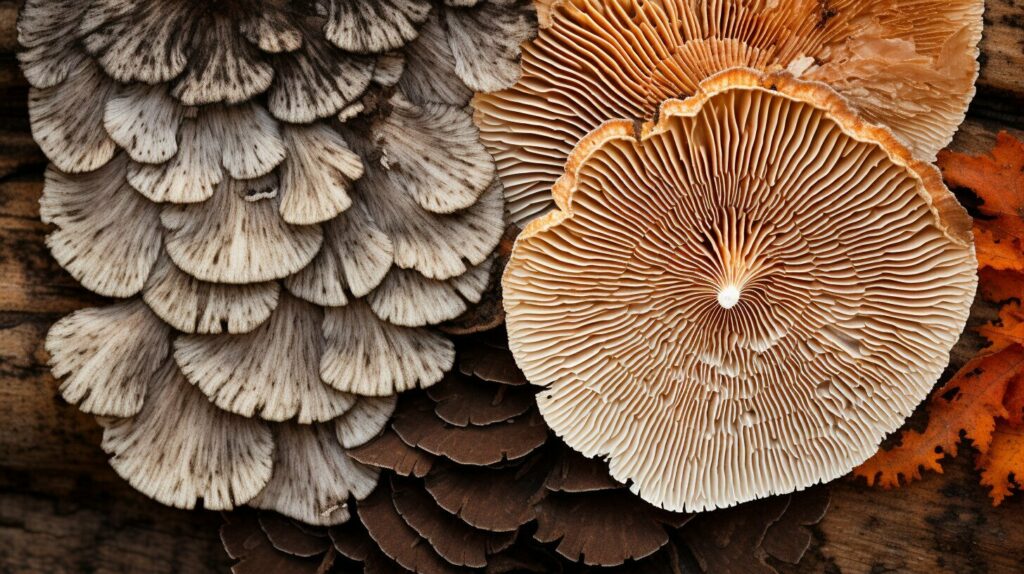
Fungi, including mushrooms, are a diverse and intriguing group of organisms that play vital ecological roles. They come in a wide variety of forms and have fascinated scientists and nature enthusiasts for centuries. Mushrooms, with their unique shapes, colors, and textures, captivate the imagination and inspire a desire to explore the fascinating world of fungi.
One of the remarkable aspects of fungi is their ability to break down organic matter and recycle nutrients back into the ecosystem. This decomposition process is essential for nutrient cycling and plays a crucial role in maintaining healthy soil and supporting plant growth. In addition, fungi form symbiotic relationships with plants, helping them absorb water and nutrients from the soil. These mutualistic partnerships contribute to the overall health and resilience of ecosystems.
Fungi also have medicinal properties and have been used in traditional medicine for centuries. Some mushrooms, like turkey tail and reishi, have been studied for their potential immune-boosting and anticancer effects. Others, such as lion’s mane and cordyceps, are known for their cognitive-enhancing and energy-boosting properties. The therapeutic potential of fungi continues to be an exciting area of research.
The Ecological Importance of Fungi
Table: Ecological Roles of Fungi
| Ecological Role | Examples |
|---|---|
| Decomposition | Breaking down dead organic matter |
| Soil Formation | Contributing to the development of fertile soil |
| Symbiotic Relationships | Forming mycorrhizal associations with plants |
| Bioremediation | Cleaning up environmental pollutants |
It’s important to remember that not all fungi are mushrooms. There is a vast array of fungi, including molds, yeasts, and lichens, each with their unique characteristics and ecological roles. Exploring the fascinating world of fungi can enrich our understanding of nature and deepen our connection to the intricate web of life on Earth.
Resources for Exploring Fungi
If you’re looking to dive deeper into the fascinating world of mushrooms and fungi, there are a variety of resources available to guide your exploration. Whether you’re interested in identifying different mushroom species, learning about their unique properties, or delving into the cultural and scientific aspects of fungi, these resources can provide valuable insights to aid your journey.
Mushroom Identification Resources
Accurate mushroom identification is crucial, especially when it comes to distinguishing between turkey tail and false turkey tail mushrooms. Fortunately, there are numerous resources available to help you with this task. Online platforms like Mushroom Observer and iNaturalist allow you to upload photos of mushrooms and receive expert opinions on their identification. Additionally, field guides such as “The National Audubon Society Field Guide to North American Mushrooms” offer detailed descriptions and photographs to assist in identification.
Books on Mushrooms
If you prefer delving deeper into the world of mushrooms through literature, there are several books worth exploring. “Mycophilia: Revelations from the Weird World of Mushrooms” by Eugenia Bone provides a captivating look into the cultural, historical, and scientific aspects of fungi. Another highly acclaimed book is “The Mushroom at the End of the World: On the Possibility of Life in Capitalist Ruins” by Anna Lowenhaupt Tsing, which explores the complex relationship between humans, nature, and mushrooms.
Online Courses
For those who prefer a more structured and hands-on approach to learning, online courses can provide a comprehensive understanding of mushrooms and fungi. Platforms like Udemy and Coursera offer courses on mushroom identification, foraging, and the medicinal properties of various fungi. These courses provide expert-led instruction and interactive learning experiences, allowing you to deepen your knowledge at your own pace.
Whether you choose to explore digital resources, dive into captivating books, or enroll in online courses, there’s a wealth of information available to help you unravel the secrets of mushrooms and fungi. These resources will enhance your understanding of mushroom identification, medicinal uses, and the ecological importance of fungi, allowing you to appreciate the intricate world of mushrooms even more.
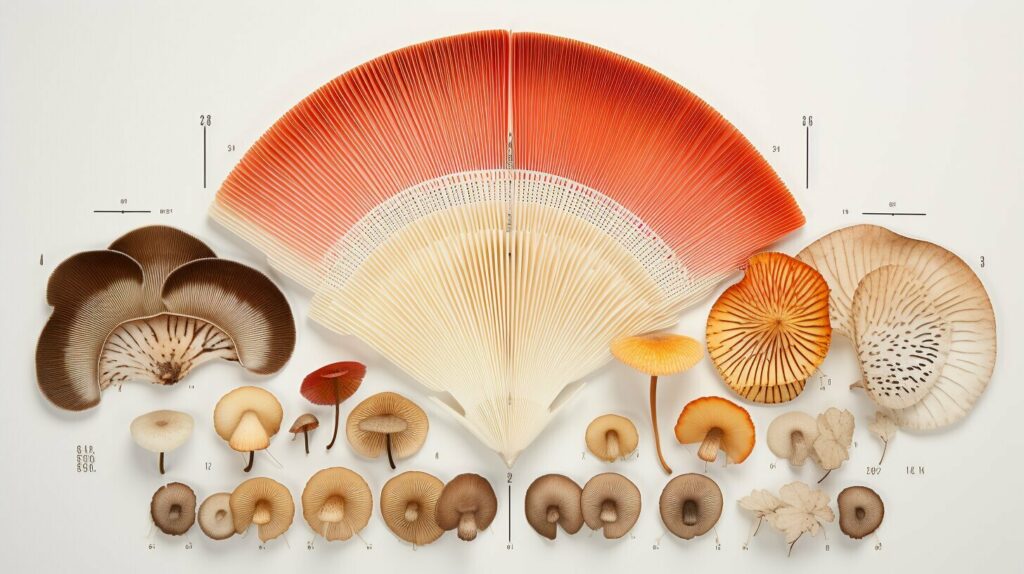
Conclusion
In conclusion, the comparison between turkey tail and false turkey tail mushrooms highlights their distinguishing features and medicinal properties. While they may share some visual similarities, it is crucial to correctly identify these mushrooms to harness their full potential and avoid confusion.
Turkey tail mushrooms have been extensively studied and are known for their immune-supporting and anticancer properties. The presence of compounds like polysaccharopeptides and polysaccharides makes them particularly beneficial for immune function and overall well-being. These mushrooms have shown promising results in cancer care, enhancing immune responses and increasing the effectiveness of treatment.
On the other hand, false turkey tail mushrooms have some antimicrobial properties but lack the potency of turkey tail mushrooms. Proper identification is essential to ensure that the desired health benefits are obtained.
Incorporating medicinal mushrooms into your routine, such as turkey tail mushrooms, can be a natural way to support your immune system and promote overall wellness. However, it is always advisable to consult with a healthcare professional before starting any new supplement or natural remedy to ensure it is suitable for your specific needs.
FAQ
How can I distinguish between turkey tail and false turkey tail mushrooms?
Turkey tail mushrooms have a vibrant and diverse color pattern with rings of various shades, including brown, tan, white, and blue. False turkey tail mushrooms have a creamier tan or brown underside without visible pores and a flatter appearance.
What are the health benefits of turkey tail mushrooms?
Turkey tail mushrooms have immune-supporting and antioxidant properties. They contain compounds like polysaccharopeptides (PSP) and polysaccharides, which can regulate immune function, enhance immune responses, support gut health, reduce inflammation, and provide antioxidant protection.
How do turkey tail mushrooms differ from false turkey tail mushrooms in terms of medicinal properties?
Turkey tail mushrooms are more potent and have been extensively studied for their health benefits, particularly in cancer care. False turkey tail mushrooms have some antimicrobial properties but are not as potent as turkey tail mushrooms.
What are some traditional uses of turkey tail mushrooms?
Turkey tail mushrooms have a long history of traditional medicinal use in various cultures. In Chinese medicine, they are known as Yun Zhi and have been used to support immune function and overall well-being. Native Americans also harnessed the healing properties of turkey tail mushrooms.
How can I consume turkey tail mushrooms?
Turkey tail mushrooms can be brewed into tea or decoctions, added to culinary dishes for flavoring, or taken as tinctures, powdered supplements, capsules, or tablets. The preparation and dosage may vary, so it is important to follow recommended guidelines or consult with a healthcare professional.
What do experts say about turkey tail mushrooms?
Experts and researchers acknowledge the potential of turkey tail mushrooms as a medicinal fungus. Clinical trials and studies have shown promising results in immune support, cancer care, and overall health. However, it is always recommended to consult with a healthcare professional before incorporating any new supplement or natural remedy.
Are there other medicinal mushrooms worth exploring?
Yes, in addition to turkey tail mushrooms, there are several other medicinal mushrooms worth exploring, such as lion’s mane (brain-boosting), reishi (immunity and sleep support), cordyceps (energy and endurance enhancement), and maitake (cardiovascular health and fertility promotion).
What is the ecological importance of fungi?
Fungi, including mushrooms, play vital ecological roles. They come in a wide variety of forms and contribute to nutrient cycling, decomposition, and symbiotic relationships with plants. Understanding the diversity and importance of fungi can deepen our connection to the natural world.
Are there resources available for learning more about mushrooms and fungi?
Yes, there are resources available to guide your journey. Books like the “National Audubon Society Field Guide to North American Mushrooms” and “Mycophilia: Revelations from the Weird World of Mushrooms” provide valuable insights and identification tips. Online platforms like Learn Your Land offer free videos and courses on mushroom foraging and tree identification.
Should I consult a healthcare professional before using turkey tail mushrooms?
Yes, it is always recommended to consult with a healthcare professional before starting any new supplement or natural remedy, including turkey tail mushrooms. Individual experiences may vary, and professional guidance can ensure safe and appropriate use.

